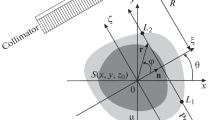Currently, there is only one example of a scattering medium for which the radiation scattering influence can be accurately taken into account. This is the proportional scattering medium. Single-photon emission computed tomography in a proportional scattering medium has been numerically simulated for a simple object (ellipse) and a complex object (Shepp–Logan phantom). The influence of the scattering on the reconstruction quality has been studied for various scattering medium proportionality coefficients and sizes of the object. The proportional scattering medium approximation can significantly improve the accuracy of the tomographic reconstruction in comparison with traditional analytical methods of reconstruction used in computed emission tomography.
Similar content being viewed by others
References
Emission Tomography: The Fundamentals of PET and SPECT, Wernick, M. N. and Aarsvold, J. N. (eds.), Elsevier Academic Press, San Diego (2004).
Yang, F., Zhang, D., Huang, K., Shi, W., and Wang, X., “Scattering estimation for cone-beam CT using local measurement based on compressed sensing,” IEEE Trans. Nucl. Sci., 65, No. 3, 941-949 (2018).
Zhao, C., Chen, X., Ouyang, L., Wang, J., and Jin, M., “Robust moving-blocker scatter correction for cone-beam computed tomography using multiple-view information,” PLoS ONE, 12, No. 12, e0189620-1-e0189620-19 (2017).
Chi, Y., Du, Z., Huang, W., and Tang, C., “Energy–angle correlation correction algorithm for monochromatic computed tomography based on Thomson scattering X-ray source,” J. Appl. Phys., 122, 234903-1-234903-8 (2017).
Berker, Y., Karp, J. S., and Schulz, V., “Numerical algorithms for scatter-to-attenuation reconstruction in PET: Empirical comparison of convergence, acceleration, and the effect of subsets,” IEEE Trans. Rad. Plasma Med. Sci., 2, No. 2, 426-434 (2017).
Altunbas, C., Lai, C. J., Zhong, Y., and Shaw, C. C., “Reduction of ring artifacts in CBCT: Detection and correction of pixel gain variations in flat panel detectors,” Med. Phys., 41, No. 9, 091913-1-091913-13 (2014).
Chan, C., Liu, H., Grobshtein, Y., Stacy, M. R., Sinusas, A. J., and Liu, C., “Noise suppressed partial volume correction for cardiac SPECT/CT,” Med. Phys., 43, No. 9, 5225-5239 (2016).
Jang, S., Kim, S., Kim, M., and Ra, J. B., “Head motion correction based on filtered backprojection for X-ray CT imaging,” Med. Phys., 45, No. 2, 589-604 (2017).
Klyuzhin, I. S. and Sossi, V., “PET image reconstruction and deformable motion correction using unorganized point clouds,” IEEE Trans. Med. Imag., 36, No. 6, 1263-1275 (2017).
D’Acunto, M., Benassi, A., Moroni, D., and Salvetti, O., “3D image reconstruction using Radon transform,” Sign. Im. Vid. Proc., 10, No. 1, 1-8 (2016).
Bruder, H., Raupach, R., Sunnegardh, J., Allmendinger, T., Klotz, E., Stierstorfer, K., and Flohr, T., “Novel iterative reconstruction method with optimal dose usage for partially redundant CT-acquisition,” Phys. Med. Biol., 60, No. 21, 8567-8582 (2015).
Tretiak, O. and Metz, C., “The exponential Radon transform,” SIAM J. Appl. Math., 39, No. 2, 341-354 (1980).
Hutton, B. F., Buvat, I., and Beekman, F. J., “Review and current status of SPECT scatter correction,” Physics Med. Biol., 56, No. 14, R85-R112 (2011).
Inui, Y., Ichihara, T., Uno, M., Ishiguro, M., Ito, K., Kato, K., Sakuma, H., Okazawa, H., and Toyama, H., “CT-Based attenuation correction and resolution compensation for I-123 IMP brain SPECT normal database: A multicenter phantom study,” Ann. Nucl. Med., 32, No. 5, 311-318 (2018).
Wu, J. and Liu, C., “Recent advances in cardiac SPECT instrumentation and imaging methods,” Phys. Med. Biol., 64, No. 6, 661-673 (2019).
Case, K. M. and Zweifel, P. F., Linear Transport Theory, Addison-Wesley, London (1967).
Kol’chuzhkin, A. M. and Uchaikin, V. V., Introduction into the Theory of Particle Passage through Matter [in Russian], Atomizdat, Moscow (1978).
Ishimaru, A., Wave Propagation and Scattering in Random Media, Academic Press, New York (1978).
Tereshchenko, S. A., Computed Tomography Methods [in Russian], Fizmatlit, Moscow (2004).
Tereshchenko, S. A., “Transmission tomography of proportional scattering media,” Zh. Tekh. Fiz., 78, No. 5, 69-75 (2008).
Author information
Authors and Affiliations
Corresponding author
Additional information
Translated from Meditsinskaya Tekhnika, Vol. 53, No. 5, Sep.-Oct., 2019, pp. 53-55.
Rights and permissions
About this article
Cite this article
Tereshchenko, S.A., Lysenko, A.Y. Investigation of the Scattering Influence on the Quality of Image Reconstruction in Single-Photon Emission Computed Tomography in a Proportional Scattering Medium. Biomed Eng 53, 370–374 (2020). https://doi.org/10.1007/s10527-020-09945-x
Received:
Published:
Issue Date:
DOI: https://doi.org/10.1007/s10527-020-09945-x




